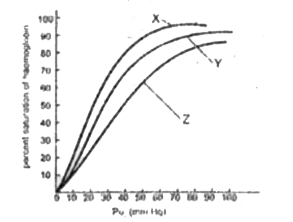Right-shift of oxygen-haemoglobin dissociation curve can occur due to
High pH
Low temperature
High H+ concentration
Low pCO2
The correct Answer is:C
To answer the question regarding the right-shift of the oxygen-hemoglobin dissociation curve, we will analyze the factors that can cause this shift.
1. Understanding the Oxygen-Hemoglobin Dissociation Curve:
- The oxygen-hemoglobin dissociation curve illustrates the relationship between the partial pressure of oxygen (pO2) and the saturation of hemoglobin with oxygen.
- A right shift in this curve indicates a decrease in hemoglobin's affinity for oxygen, meaning hemoglobin releases oxygen more readily to the tissues.
2. Factors Leading to Right Shift:
- Several physiological factors can cause a right shift in the curve:
- Increased Partial Pressure of Carbon Dioxide (pCO2): Higher levels of carbon dioxide in the blood lead to a decrease in pH (more acidic conditions), promoting oxygen release.
- Decreased pH (Increased H+ Ion Concentration): A lower pH (more acidic) increases the concentration of hydrogen ions (H+), which also promotes a right shift.
- Increased Temperature: Higher temperatures reduce hemoglobin's affinity for oxygen, facilitating oxygen release.
- Increased 2,3-Bisphosphoglycerate (2,3-BPG): This metabolite increases in red blood cells during conditions of low oxygen, promoting oxygen release.
3. Evaluating the Given Options:
- High pH Value: This would not cause a right shift; it would actually favor a left shift (higher affinity for oxygen).
- Low Temperature: This would not cause a right shift; higher temperatures are needed for a right shift.
- High H+ Ion Concentration: This is correct as it indicates lower pH, which promotes a right shift.
- Low pCO2: This would not cause a right shift; higher pCO2 is needed for a right shift.
4. Conclusion:
- The correct answer is that a right shift of the oxygen-hemoglobin dissociation curve can occur due to high H+ ion concentration (which corresponds to lower pH).
Final Answer:
The right-shift of the oxygen-hemoglobin dissociation curve can occur due to high H+ ion concentration.
- The oxygen-hemoglobin dissociation curve illustrates the relationship between the partial pressure of oxygen (pO2) and the saturation of hemoglobin with oxygen.
- A right shift in this curve indicates a decrease in hemoglobin's affinity for oxygen, meaning hemoglobin releases oxygen more readily to the tissues.
- Several physiological factors can cause a right shift in the curve:
- Increased Partial Pressure of Carbon Dioxide (pCO2): Higher levels of carbon dioxide in the blood lead to a decrease in pH (more acidic conditions), promoting oxygen release.
- Decreased pH (Increased H+ Ion Concentration): A lower pH (more acidic) increases the concentration of hydrogen ions (H+), which also promotes a right shift.
- Increased Temperature: Higher temperatures reduce hemoglobin's affinity for oxygen, facilitating oxygen release.
- Increased 2,3-Bisphosphoglycerate (2,3-BPG): This metabolite increases in red blood cells during conditions of low oxygen, promoting oxygen release.
- High pH Value: This would not cause a right shift; it would actually favor a left shift (higher affinity for oxygen).
- Low Temperature: This would not cause a right shift; higher temperatures are needed for a right shift.
- High H+ Ion Concentration: This is correct as it indicates lower pH, which promotes a right shift.
- Low pCO2: This would not cause a right shift; higher pCO2 is needed for a right shift.
- The correct answer is that a right shift of the oxygen-hemoglobin dissociation curve can occur due to high H+ ion concentration (which corresponds to lower pH).
The right-shift of the oxygen-hemoglobin dissociation curve can occur due to high H+ ion concentration.
Topper's Solved these Questions
- BREATHING AND EXCHANGE OF GASES BOOK - AAKASH SERIESCHAPTER - BREATHING AND EXCHANGE OF GASES EXERCISE - EXERCISE-I (Regulation of Respiration)
15 Videos
- BREATHING AND EXCHANGE OF GASES BOOK - AAKASH SERIESCHAPTER - BREATHING AND EXCHANGE OF GASES EXERCISE - EXERCISE-I (Disorders of Respiratory System)
9 Videos
- BREATHING AND EXCHANGE OF GASES BOOK - AAKASH SERIESCHAPTER - BREATHING AND EXCHANGE OF GASES EXERCISE - EXERCISE-I (Exchange of Gases)
21 Videos
- BODY FLUIDS AND CIRCULATIONBOOK - AAKASH SERIESCHAPTER - BODY FLUIDS AND CIRCULATIONEXERCISE - Exercise -III (Previous AIPMT/NEET Questions)
35 Videos
- CHEMICAL COORDINATION AND INTERGRATIONBOOK - AAKASH SERIESCHAPTER - CHEMICAL COORDINATION AND INTERGRATIONEXERCISE - Exercise-III (previous AIPMT/NEET questions)
41 Videos
Similar Questions
Knowledge Check
The oxygen dissociation curve is
AparabolaBslopeCsigmoidDstright line.The oxygen - haemoglobin dissociation curve will show a right shift in case of
Ahigh PCO2Bhigh PO2Clow PCO2Dless H+ concentrations
The following oxygen-haemoglobin dissociation curves explain the effect of pH on oxygen-affinity of haemoglobin. Find out option that gives the correct descending order of pH for X, Y and Z.

View SolutionGo through the following statements
(i) the peripheral chemoreceptors for regulation of respiration are located in carotid veins and arch of aorta
(ii) the primary effect of pneumotaxic centre is to control the switch off point of inspiratory signal and thus limit inspiraton
(iii) the chemosensitve area for brain for respiratory control is highly sensitive to O2 concentration
(iv) In case of fetal haemoglobin the oxygen haemoglobin dissociation curve is shifted toward left
which of these are correct ?
(a) i, ii & iv
(b) ii and iv
(c) ii, iii & iv
(d) iii and iv
View SolutionThe oxygen - haemoglobin dissociation curve will show a right shift in case of
View SolutionThe oxygen - haemoglobin dissociation curve will show a right shift in case of
View SolutionOxygen dissociation curve of haemoglobin is
View SolutionThe dissociation curve is associated with
View Solution
